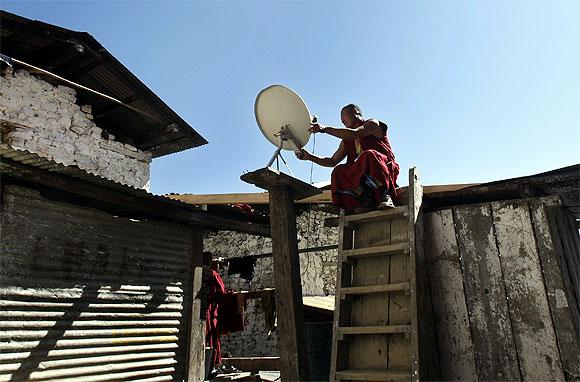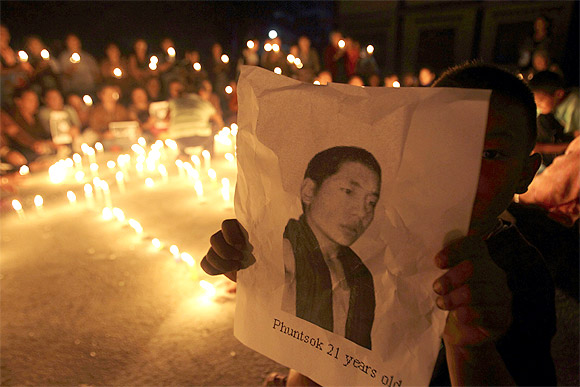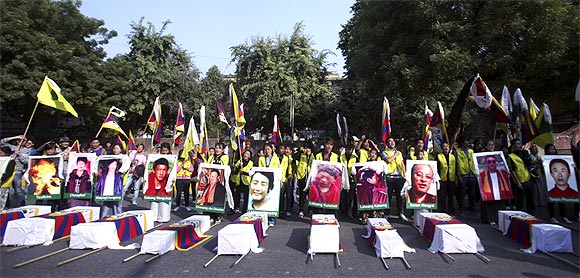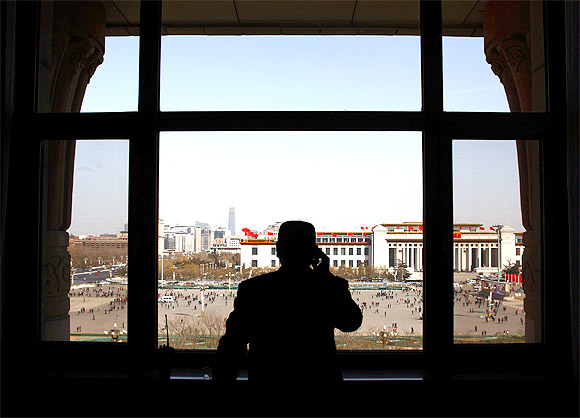 | « Back to article | Print this article |
Bumbling do-gooders CAN'T resolve Tibet row
The notion that New Delhi can talk Beijing into engaging the hated 'Dalai clique' is entirely fanciful, says Ajai Shukla
In Arunachal Pradesh, where I travelled over the last 10 days, there is little illusion about the brutal character of Beijing's rule over Tibet. Even Itanagar's politically aware youngsters, who angrily contrast infrastructure development across the McMahon Line with the slothfulness and corruption in their own state, know about the paranoia that makes Beijing perceive in every Tibetan shadow a threat to the core interests of the Middle Kingdom.
Which was why I was startled, on my return to Delhi, to find an illustrious group of Indian thinkers recommending that Sino-Indian tensions be eased by "persuading China to seek reconciliation with the Dalai Lama and the exiled Tibetan community".
Their policy paper, entitled "Nonalignment 2.0: A foreign and strategic policy for India in the twenty-first century", declares, "The Dalai Lama's popular legitimacy among his own people is a fact that the Chinese government must acknowledge."
The authors of this quixotic proposal -- Sunil Khilna#8715 Rajiv Kumar; Pratap Bhanu Mehta; Lieutenant General (Retired) Prakash Menon; Nandan Nileka#8715 Srinath Raghavan; Shyam Saran and Siddharth Varadarajan -- do not represent the Indian government. But the preface notes that National Security Advisor Shivshankar Menon and his two deputies, Alok Prasad and Latha Reddy, also provided inputs.
Click on NEXT for more...
Self-immolation has emerged as an expression of protest
The notion that New Delhi can talk Beijing into engaging the hated "Dalai clique" is entirely fanciful. Tibet, alongside Taiwan, remains the deepest of China's many insecurities. Beijing considers India the biggest potential external threat to its brutal stranglehold over Tibet, just like America is its bugaboo on Taiwan.
India provides life support to the Dalai Lama and the Central Tibetan Administration even as global leaders co-operate with Beijing in spurning His Holiness. Tibet's historic monasteries -- Ganden, Sera and Drebung amongst them (traditional power centres that China has desecrated and emasculated in Tibet) -- now radiate influence from mirror-image establishments in southern India.
And India's 100,000-strong Tibetan refugee community is a potent reservoir for fomenting a major uprising in Tibet whenever New Delhi chooses. For Beijing, the idea of taking advice on Tibet from such a key potential adversary would be anathema.
Compounding Beijing's misgivings would be its failure to extinguish simmering opposition within Tibet. Since March 1989, when martial law was imposed in Lhasa (three months before the PLA's massacre of protesters in Tiananmen Square), Tibet has been subjugated by a security establishment so repressive that self-immolation has emerged as the only feasible expression of protest.
Click on NEXT for more...
Development has involved resettling rural Tibetans
Given the paranoia that drives Beijing's militarised control, even self-immolation is treated as a challenge to the regime. Many Chinese security personnel in Tibet's cities now tote small fire extinguishers alongside their intimidating array of weaponry.
Last week Premier Wen Jiabao blamed self-immolations on "disaffection" spread by the Dalai Lama, intended to split Tibet from China. Wen declared that Beijing has a "firm position" on this.
Wen's "firm position" has taken the form of a two-pronged strategy of "stability" and "development". The former is the euphemism for essentially handing over Tibet to a multitude of security agencies that range from the feared People's Armed Police to a growing rash of outfits that are given to black, commando-style uniforms and heavy truncheons.
"Development" has involved resettling rural Tibetans into depressing cinder block communities from where they must pursue professions that are alien to the Tibetan tradition.
Click on NEXT for more...
Beijing's going-nowhere talks with Dalai Lama's representatives
This has served only to deepen resentment. In 2008, riots broke out outside the Tibet Autonomous Region, across the Tibetan-inhabited areas of Amdo and Kham, which are now in the Chinese provinces of Sichuan, Gansu and Qinghai. That outbreak of rebellion continues in various forms even today.
In these poisoned circumstances, bumbling Indian do-gooders who seek to encourage dialogue would hardly be welcomed. How would Delhi have reacted to Pakistani suggestions to engage with Syed Ali Shah Geelani during Kashmir's summers of rioting from 2008 to 2010? Remember, Beijing's visceral hostility towards the Dalai Lama far exceeds Delhi's animus to Geelani.
Nor should Nonalignment 2.0 forget Beijing's going-nowhere talks with the Dalai Lama's representatives, which have sputtered along since the 1990s.
This has allowed China to appear reasonable while conceding nothing. Beijing indicates that the only things to be decided are: when the Dalai Lama would resume his position as vice-chairman of the National People's Congress; and in which part of Beijing he would like to reside after returning to the motherland.
Click on NEXT for more...
New Delhi must reposition Sino-Indian dialogue
Qu Xing, director of the officially affiliated China Institute of International Studies, indicated Beijing's approach last year. Referring to Tibet as a Chinese core interest, Qu said, "An important criterion of core interests is that they are not allowed to be negotiated and no compromise can be made on [them]."
For decades, New Delhi has danced to the Chinese tune, shrinking from even mentioning Tibet for fear of angering Beijing. This has allowed China to keep the spotlight on Arunachal Pradesh and, therefore, off its deepening vulnerabilities in Tibet.
New Delhi must now strategically reposition the Sino-Indian dialogue, turning the spotlight squarely onto Tibet and asserting our legitimate interests there.
These include border #8482 religious linkages; people-to-people contacts; and the reopening of India's consulate in Lhasa that was shut down in the 1950s. India's regrettable abandonment of Tibet in 1950 and the abject surrender of the 1954 Panchsheel Agreement are now unchangeable history. But self-interest now demands a more realistic and assertive stance on Tibet.
Click on NEXT for more...






